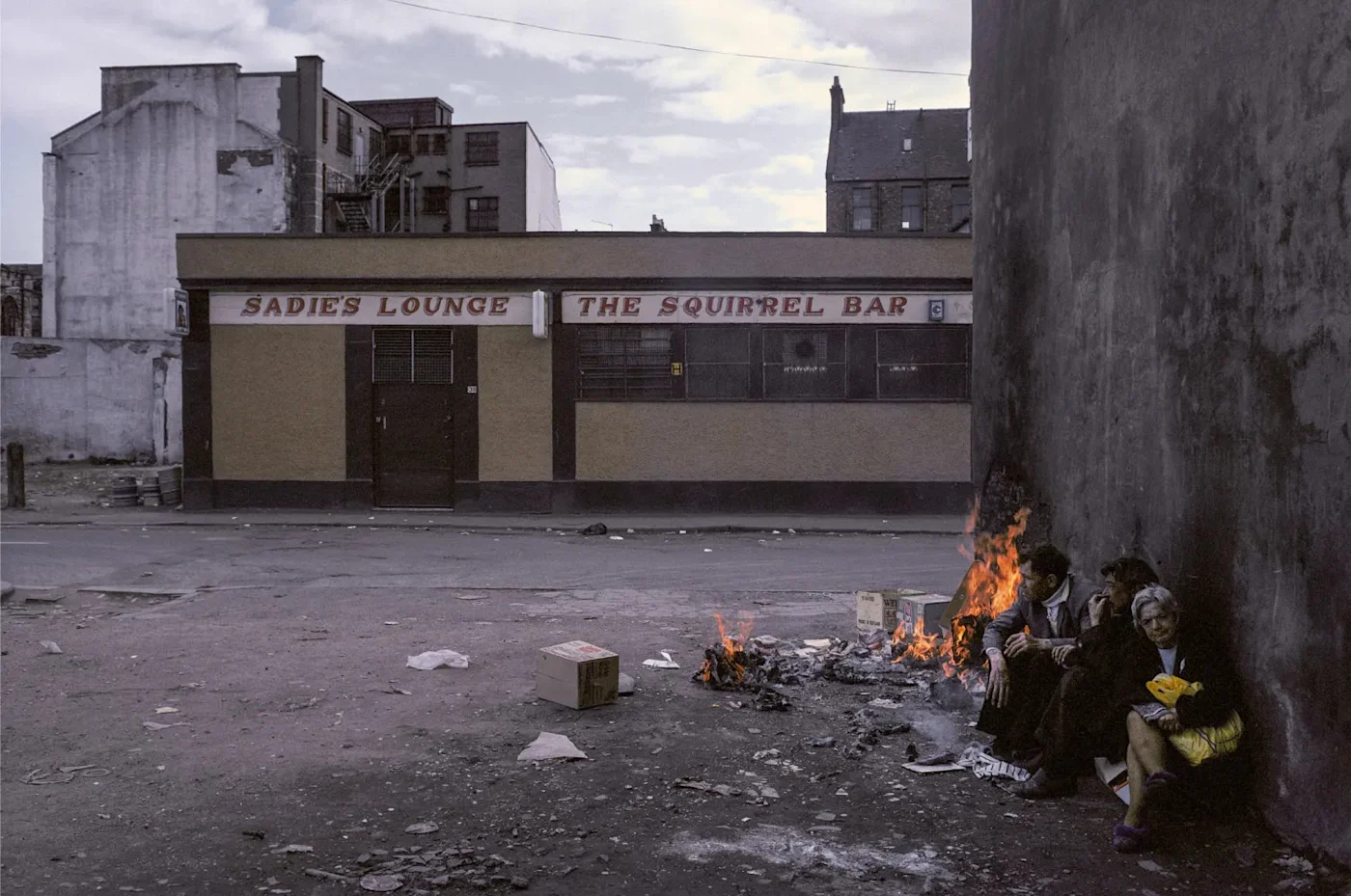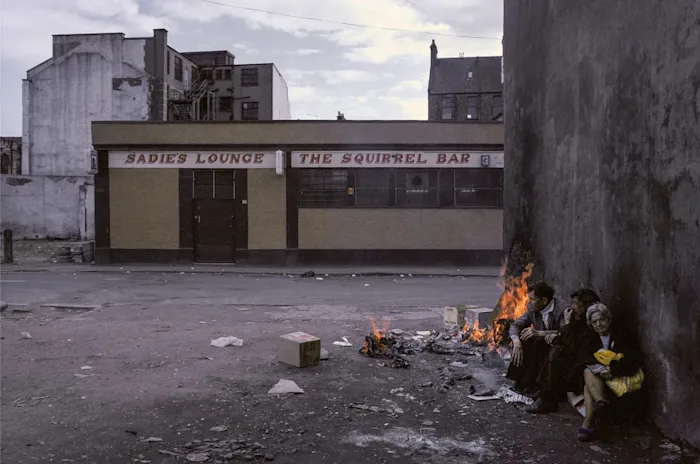The Strategy of Separation
Michele Garau
In a time of revolutionary confusion, it is urgent for partisans to make clear the wagers on which we are operating. What do we hope for from social movements, ecological struggles, anti-infrastructure blockades, or anti-war mobilizations? How can smaller conflicts outstrip their initial premises in order to grow into bigger ones, while avoiding the pitfalls of recuperation and reformism? Have our strategic wagers taken into account the growing consensus between advocates of “smart” surveillance, green capitalism, and control societies? What unholy alliances might emerge if those refusing these manifold dystopias were suddenly to link up?
In a searching reflection on revolutionary horizons today, Italian philosopher Michele Garau — author of “Without Why” and “The Community of Capital” — argues that revolutionaries must break with the sovereigntist lexicon of the “left.” Instead, we should turn our sights upon the reservoir of communal heresies and ethical secessionism that expresses itself through the violent refusal of cybernetic hegemony, from technology to ecology. Engaging a wide range of interlocutors from Kropotkin, Bordiga, Cesarano and Camatte to more recent writing by Hugh Farrell, Mauvaise Troupe, Jerome Baschet, Adrian Wohlleben, and Phil Neel, Garau sets out in search of new routes for escape and desertion from the present.
Other languages: Italiano, Français, Español, Deutsch (p. 16)
Over the past few years, the last fragile stitches that held the patchwork of revolutionary politics together have been ripped out. Few if any initiatives have generated any glimmers of clarity, let alone anything resembling a path forward. Everywhere, we grope in the dark. However, if we wish to exit this darkness, we must first find ourselves in the midst of it, bring it into focus. From within this darkness, we must then attempt, bit by bit, to survey our condition, to sketch maps. If we wish to escape our current weariness, which delivers us over to the language of our enemies, we must find the words we presently lack. Beneath the superficial chatter, we must trace the contours of our own proper camp. Our present is non-contemporaneous: in addition to the prevailing intelligence of our rulers, it is also pregnant with the defeats of the past.
Our rulers are accustomed to reshuffling the deck. They don masks and employ idioms that can lead us to doubt the axes of conflict. “Progress,” “solidarity,” and all that belongs to the left now serve as the chief rationality of government, while invocations of "society" and the "environment" are little more than imperative techniques designed to annex us to a power that is technical and political, moral and ideological, scientific and police-like. A power that takes on the features of the universal through a synthesis that goes beyond the invisible synthesis of technology, with its apparatuses and flows that regulate our behaviors through the gentle push of convenience, against a backdrop of “solutions” coercively suggested to us by screens and digital identities, entertainment and routine. Through its contact with the reagent of emergency, the universal today becomes what it has always been: the violent compulsion of blackmail, tinged throughout with the last remnants of Morality, Truth, Reason, and the Common Good. An imperialist, immanent synthesis that obliterates all that stands in its way, a continuous biopolitical fabric that must not be interrupted. A fierce political enmity awaits anyone who eschews its ideological regime of truth, which, however totalizing, nevertheless has its own limits and relativity: just consider the annihilating cocktail of condescension, deprecation, and “care” reserved for those who flout the imminence of “common” dangers and the responsibility to combat them. The social emergency, the sanitary emergency, the climate emergency, the democratic emergency touches us all, they come backed up by objective data, like self-evident facts that we are not permitted to ignore, which there are no good reasons to oppose. Linguistic appropriation and ethics-washing are contemporary epiphenomena of the ancestral wrong that the man of the word commits against the man of need, who feels in his body, beyond all discourse, that he has been swindled. And what is a swindle, but a use of the word that blurs with reality, that digs at the root of sensible certainties by making them sluggish, insinuating doubt. Confronted with it, the man of need — who needs truth and communication above all — feels he can only react with mute violence:
Each of us has personally witnessed a thousand times the great spectacle of the dialogue between a simple man and an expert in clear language. The man of clear language speaks, advances reasons, relies on countless arguments: he alone has the arsenal of arguments. He therefore has the advantage. He is irrefutable. He has the last word. The other, the one who has no clear language because his situation, which he has not idealized, is not clear, cannot in the end but keep silent, and seems to admit he is wrong. The next moment we find him ashamed, but persuaded that he is right, without a clear reason. It seems to him, then, that this clear language that proves him wrong can only be overcome by violence. And rightly so. Clear language is a simplification. It is not just any simplification, it’s idealist simplification. To live up to the revolution's lack of clarity, we must first renounce the rational illusion of clear language.1
The uprisings that have erupted one after another — against normality, emergency, sanitary confinement, or the police — the “non-movements” giving vent to an enormous fever of rejection, to wild, anti-ecological, anti-social and irrational eruptions of power, are precisely that.


Humanity is asking questions to which it cannot yet provide answers. Both because there’s no longer any subject who answers to the name “human” — there is no community of the species beneath the community of capital — but additionally, because the language we rely upon to point out our problems is a false currency. If “solidarity” can signify warlike mobilization, panoptic surveillance, and the marginalization of anyone who refuses to go along, then anyone who sets out to demonstrate, starting from where he or she stands, that supine acceptance has its limits cannot help but appear to the rest as selfish and inhumane. The novelty of our current epistemological regime lies in the transformation of the very insignia of social bonding and science into pure synonyms for governmental force, and nothing more. When we look at the world, we see only a pluralism of beliefs and epistemological ruptures that reaches all the way down to the bottom of reality: alternative visions proliferate, narratives and kernels of truth divide and multiply in the public arena of digital expression, that neutral and horizontal plane on which any criterion of certainty is either lost, does not exist, or generates suspicion. What gets passed-off as science is simply whatever measure, law, or imposition is decided to be so. What passes for morality and responsible behavior is whatever cooperates in the furtherance of the routine circuits of production and consumption, while anyone who blocks or obstructs them is cast as dangerous and nihilistic. Labor, consumption, and circulation are on the side of the good; protest, noncompliance, and even doubt fall outside the anthropological spectrum of worthy motives.
First stage
The intersection between this new morality and epistemology and the entire continent of digital latticework euphemistically subsumed under the label "artificial intelligence" has strategic implications worth reflecting upon. An entire suite of default settings, invisible constraints, and obligatory scenarios is incarnated in technological devices, steering our behavior in the direction of incremental accumulation, like a quid of power that renews itself through our every gesture, act, and choice. Such tracks and pathways ensure a form of enclosure through continuous classification, a process that conceals its embeddedness within the matrix of technology, shrouding archaic forms of power behind the veils of progress.2 Old forms of oppression are thinly painted over with the hue of the new, in the form of freshly-dyed algorithmic computation in telematic interfaces that simulate AI responses for the user's pleasure, concealing the existence of the human operator within them. When discussing algorithmic power, one must keep in mind that the apparatuses of classification and artificial intelligence, with their percentages of predictive accuracy and scientific exactitude do not describe the subjects and behaviors whose reality they claim to report and whose decisions they influence; in fact, they create them, through their own categories. The extraction and imposition of data operates by means of performative feedback loops that reiterate and crystallize their results through recursive verification, adjusting subjects to the truths produced about them in real time. Recursiveness and performativity are what make data effective at the same time that they appear to confirm it, thereby producing the superficial rationalistic illusion of a disembodied gaze that is nowhere to be found.
Each time it carves out a label on someone, this form of classification imposes an injunction to conform to the positive truth that the objectification apparatus proffers as a scientific framework applicable to that class of individuals, leading to an additional degree of consolidation of the datum in the next iteration of the reinforcement spiral.3 If it is not at all surprising that the application of algorithmic software to the organization of labor, incarceration, the functioning of the courts, or the allocation of benefits replicates racist and misogynist biases of normality and abnormality — the deep class violence inscribed in the worldview, and thus in the data archives, of the institutions on which they depend — it must be borne in mind that there is nothing essentially new in all of this. The use of mathematical criteria to cover over the operational circularity of one's instrumental frame of inquiry (the results being shaped and consolidated with each new application of the instrument), a psychotically rationalist and positivist idea of modeling an optimal division of things, behaviors, types of people — this is what makes the AI sphere a devastating continuation of the legacy of epistemic violence of its direct ancestor, statistical science. That the vast paraphernalia of this science has, since its inception, been intimately penetrated by the systematic program of social Darwinism, racial supremacism, and eugenics pursued by all its founding fathers (from Spencer to Galton, from Grant to Pearson) with its profound urge to define and promote the “fittest” characteristics for the strengthening and reproduction of the social machine, has in no way prevented its vocabulary and outlook from being consecrated today at the heart of the state's gaze. Its core has now been transplanted into the center of the algorithm, where the "datafication" of the world is not content to reflect the world but instead induces, imposes, and encloses: it is because of the tremendous effectiveness with respect to this objective that, despite the constant and omnipresent gaps in its knowledge, it continues its path through forced stages.
“Crowdworking,” testing, and data collection are methods by which dispossessed subjects perform their own mechanical reduction to static and fixed forms of calculable value adapted to probabilistic forms of management whose end is less cognitive than it is instrumental: its aim is to fashion the object whose truth it renders through a feedback effect designed to bolster the foundations of the apparatus. In this mechanism, we see the coexistence of maximum virtualization with an intensity of exploitation indexed to absolute surplus value, an algorithmic extractivism equal parts physical and spiritual. This is how archaic layers of time manage to conceal their persistence behind the smart facade. However, there is also a non-contemporaneity4 of the present, owing to the quality of the "human" as openness and meaning, as a remnant irreducible to the machine and its manipulable background. This quality carries features and lexicons antithetical to the horizons of progress and the left, a slight yet stark parenthesis that stands in opposition to the image of the human evoked by the sirens of “contemporary transhumanism.” In his 1969 letter to Jean Beaufret, Heidegger already observed that, as a metaphysical conception, humanism does not have a high enough idea of the human, which it reduces to a substance and a static genus rather than seeing in it an openness, and thus an always incomplete possibility. Transhumanism carries within it the metaphysics of technicity, in quite the same way that all operational classifications concealed behind technological apparatuses serve to diminish the human, i.e., by fossilizing it into an identity, into something stationary and separable that, pinned down through the checkering [quadrillage] of information gathered about it, can be manipulated at will.


The “spurious” movements or “non-movements” that bubble up into the repertoire of revolt are unrecognizable through the political grammar transmitted to us, over the decades, by the imaginary filiations of the labor movement sequence. For this reason, such revolts identify — instinctively but lucidly — their enemy in the figure of the left5, but they automatically adopt a posture of a reaction to its traitorous logic. There is a reason for this semantic shift: the “common good of the climate” consists in the declaration of a state of emergency and the revalorization of nuclear power; the capitalist restructuring that destroys water and land in the name of renewable energy wears a “green” face; finally, a mass experiment in exclusion from the possibility of “public” existence — supported by a telematic license — becomes the forerunner of new horizons of forced socialization. It is therefore understandable that the responses to these forward leaps in command hit with surprising precision upon all the strategic cores of domination, even if they are indeed marked by a conspicuous tendency toward mirroring. The uprisings of the future will be anti-ecological and “right-wing” precisely because they recognize all the “good reasons” levied against them as little more than governmental techniques designed purely and simply to silence them. What is not certain, however, is that being proscribed from public existence, reduced to the unspeakable and the unpresentable, cannot still be the condition for firmer and more fierce separations. Conspiracists, anti-vaxxers, anti-Westerners, and other defectors from the “good” front are a black box in which informational frames are likely to run aground. There is no predicting what will come of them. To base the operations of power on a declaration of endless emergency always contains a baseline risk of setting the stage for a genuine emergency.
Folk devils
How are we to position ourselves within this field? This is the burning question facing those revolutionaries who have the courage not to let themselves be blinded. Those who saw in the emergency measures during the pandemic period a total mobilization that challenged all our presuppositions, those who read in what was played out behind and through the sanitary aspects of Covid-19 a decisive leap that left its mark, from which no return to normality was really possible, must equip themselves with new tools. If the withering of hegemonic principles is the mark of an anarchic and unfounded power, if what Camatte calls the crisis of representation leaves value to function like an empty shell that feeds on itself, like naked power, then it seems like there is still the possibility of an ethical secession outward, a tear in the fabric of command that we struggle to pinpoint and define. It exists, and it is frightening. The phenomena of dissidence centering on the pandemic, health care, war, social unity, and progress are this monstrous unevenness that, reduced to a series of Xeroxed folk devils (anti-vaxxer, Putinist, conspiracist, climate denier, nihilist looter from the banlieues), reflects a command structure that is morally imperative only insofar as it reacts to the void of unitary values, only to be irremediably returned to its discursive and epistemic plurality. The “radical” left, meanwhile, demands from the uprisings a transcendence, an aerial viewpoint and a (recognizable and credible) horizon of meaning that is no longer to be found anywhere, and which even the left itself no longer possesses. The innumerable invectives hurled against the anthropological and cultural subalternity of the insurgents, as the sphere of sovereign individuals whose mode of existence bears the stain of their subordination to neoliberal hegemony as its other face, betray a basic misunderstanding of what revolutions have always been about.
Consciousness, the being of theory and the being of class, the positive determination of the political project starting from material life — class in itself and class for itself — still stands in the same vicious circle as always, recurring first as tragedy and second as farce. From the Italian underclass who set Piazza Statuto on fire, to the suburban residents looting stores out of foolish stubbornness, the stigma is the same today as it was yesterday, even if few seem to realize it. Others instead draw repugnant conclusions6: indeed, capitalist anthropology contaminates the uprisings of the racialized with the same savage negativity that is expressed in all uprisings. Yet we hasten to draw the lines, as if to keep the barbarians at bay.7
While it is true, as Joshua Clover notes, that during the interregnum period between repertoires of action that defines our transitional epoch the space of circulation partially takes over from the space of production, one cannot draw from this a “political economy of conflict.” This contradictory idea leaves us backtracking indefinitely in search of criteria of where a struggle within a struggle is possible and where, instead, popular anger is ontologically consigned — as Clover has essentially said on several occasions about the uprisings of the pandemic phase — to a reactionary political direction. All that is left is a circular oscillation between the two contradictions of the determinism of class composition and the fetishism of speech. On one side, we see a regression from formal repertoires — gestures and practices — to the centrality of subjects, mostly sociologically delimited by the hierarchy of capitalist relations. From there, one proceeds to mechanically derive the possibility of a bifurcation of conflicts from an obtuse Marxist reading of social fractions and class. The result is a blatant error, for in the eyes of anyone who can see, the non-movements of the Gilets jaunes, the Freedom Convoy, the protests against the health pass or even, years ago, the Forconi in Italy are united not only by the same repertoire of action, but also by the same heterogeneous pool of proletarianized social forces. We are then left with the second option, which throws the prism of circulation struggles right back into the leftist field: the yardstick for evaluating redeemable struggles becomes utterances that refer to the field of emancipation, to a politically recognizable language. Needless to say, this metric does not work either, since it only entrenches the trivial liberal image of political conflict modeled on dialogue and the exchange of viewpoints between subjects, instead of identifying the nodes that struggles materially touch.8


In a book that still remains among the best works on Marx, since it points out his metaphysical debts to the project of modern technique, Kostas Axelos exposes the fallacy in the idea that the dialectic between two classes or social forces resolves the rupture within an historical formation and enables its overcoming: in fact, dualistic antagonisms are broken by a third force that bursts in from outside and changes the framework of historical existence.
The transition from one historical stage to the next did not result from the victory of the exploited over the exploiters but from an internal exhaustion and the manifestation of a new “third force.” Dualistic antagonism was being suppressed and overcome by a third force that suppressed and overcame the two warring parties; the Romans achieved victory over the Greeks, and the Barbarians suppressed the Greco-Roman world, unable to survive; and the Middle Ages found its end thanks to the development of the bourgeoisie and “independently” of the struggle that opposed barons and serfs. Therefore, how can we rule out the possibility that the current antagonism (capitalists and proletarians) will be suppressed and overcome without there being any final victory of one over the other, but instead by the development of a third solution which can certainly arise from within?9
It is this third force that concerns us here, this residue with respect to the machinic, the visible, and the valorizable. A profound and hidden force that becomes a substance only when it is already caught in the extractive and computational machine of the algorithm or biopolitical surveillance. This is why, in posing as a program for the management and implementation of rational solutions to the catastrophic fallout of capitalist dystopia, it is correct to describe political ecology as essentially extractivist.10 For it incorporates and ingests into the networks of the market what had previously remained invisible to the modern quadrature of the sovereign subject and its colonizing techniques: nature, the nonhuman, reproduction, non-labor, or even the Outside as such (which it then ceases to be). As Cesarano recognized already in 1973, the utopia of capital is no longer merely the continuous and increasingly uninhibited assimilatory expansion toward new free resources, the unbridled appropriation that will crash thunderously against the wall of our biophysical limits, for it can and must combine this face with the assimilation of ecological consciousness as extractive exploitation of the consciousness of the species. In order to maintain the same project in other ways, the quest for new sectors, new concerns and new solutions means the planet's actors must finally be taken into account and connected. Political ecology provides the supplement to the terminal life of political economy.
What has been referred to as the “problem of composition” circles around the same insight, while partly misunderstanding it. In the anarchic age of a capitalism with no more hegemonic ghosts, the maelstrom of dispersed subjectivities that the totalizing universe of the labor movement leaves orphaned gives rise to disorientation and a field of experimentation. Instead of exerting an overpowering stranglehold, identity politics can become "non-movements" that spring up around partial and fragmentary issues which, at their peak of intensity, can transcend themselves and upend their own initial coordinates and framing. In today’s revolts, the splinters in the postmodern mosaic of plural identikits self-negate, as in the old revolutionary eras classes had to self-negate. With the difference that here there is no dialectical transition that unfolds on its own, and no one is under any illusions about that. At the same time, the strategy of adding one struggle to another — racialized plus exploited, plus women, plus the precarious, plus students, plus ethical extremists, plus... — doesn’t lead anywhere, precisely because at the peak of these conflicts the protagonists, with their already precarious contours, only blur even further. Perhaps the question, at this point, is not to compose struggles starting from their reasons and differences, which runs the risk that the vital network of nuances and folds reproduces the enveloping fabric of a democratic political reason (from the parliament of things to the parliament of struggles); perhaps it is a question, instead, of rendering the reasons behind these struggles themselves inadmissible.
An uprising of motorists against the costs of circulation requisite for their job becomes the emergent site of a people who did not exist (an “ecstatic populism,” as some have called it); a wave of riots following the death of George Floyd acquires a composition that, at its most radical, is no longer even majority black; finally, the protests against emergency health measures to contain Covid-19 express, in nuce, a mass unwillingness to allow oneself to be governed. Class cannot be located in any one of these identity boxes, in which the subversive force is reduced to a static genre and basis of government, but is precisely the anonymity that emerges when these boxes are broken. As such, it is obviously no longer class, since it cannot be classified.
When identity politics is reproduced in this way, it can generate violent legitimations of normality and provide inroads for government operations. We must be careful where we look, which camp we choose, because the language of the enemy is inscribed in the easiest of options. Exclusionary environmentalist restructurings of public space, feminisms11 and ideologies of care that lend themselves to authoritarian biopolitics, minority protections and military campaigns are no less dangerous slippages than those who, in the heat of struggles, mix with the so-called “conspiracist” nebula (a word that encapsulates a deadly apparatus for preemptively defusing any critical weapon).12 In this nebula will emerge the thrust of many future struggles. What counts is to find a mode of convergence capable of deserting the enemy camp in pursuit not of a purity of language but of a genuine force of separation. In this sense, an ecological struggle against the impact of renewables and wind power, or against the “green” destruction of an ecosystem, for example, offers more opportunities than other sorts of demands. Either the point of connection is found between the spurious movements of the conspiracist universe — the unidentified political objects of rebellions moving against the left — and, on the other side, all that remains most vital in the struggles for the environment, beyond and at the margins of political ecology; or, failing this, the latter will be irretrievably consigned to recuperation and instrumentalization by the enemy, while the nebula of alternative truth regimes, left to its spontaneous becoming, will remain captured within reactionary bifurcations. It is conspiracism that can save ecological struggles and redeem their meaning, outside of and against the left, not the other way around. Forget explaining to the uncivilized that the enemy is not the “Great Reset” but capital. It seems clear that a revolutionary and strategic solution to these problems cannot be reduced to the old pedagogical idea of competing for hegemony, of the battle over ideas and proposals. We need to place some other elements on the table.
Forms of separation
When it comes to our understanding of how a sequence of uprisings can spill over into a revolutionary becoming — the so-called “transcrescence” of struggles — there is a great emptiness on our side. This is a theoretical and strategic flaw, but even before that, it’s an imaginative one. Once we set aside the various social democratic formulae with their flimsy claims to radicalism (constituent power, instituent power, interstitial power, dual power, neo-statism, neo-mutualism…you name it), it becomes clear that all currently existing sketches of strategic revolutionary thinking are forced to traverse the tangled knot of “autonomy.” However, this term has been reinvented beyond its earlier operaist acceptance a thousand times, taking on new meanings, formulations, and perspectives, so that what we're left with today is by no means clear and unambiguous.
On the one hand, recall Bordiga's critique of councilism and self-management which, generally speaking, was a critique of the compromise that occurs wherever revolutionary upheavals and communism are understood through their continuity with capitalist society. In the case of reformism, this continuity lies in its political apparatuses, whereas with mutualism or councilism it lies in the organs of economic management. This critique can be found in the text “The Goals of the Communists,” where Bordiga attacks the position taken by the Ordine Nuovo journal concerning factory occupations. However, even if the institutions that today purport to offer a bridge over the “great catastrophe” of a full-blown communist revolution against the current mode of production — while downplaying the depth of the schism between these — no longer revolve around the working class but some other subject (or non-subject), even still Bordiga’s critique has lost nothing of its force.13 This is essentially Phil Neel’s thesis, after all, when he dismisses the vague ambitions of libertarian islands in favor of the potency of an insurrectional dynamic that must arise from the immanent limit of class struggles.14 As Neel insists, it’s either self-satisfied communitarian proximity or the experience of revolts. And he’s not wrong.
On the other hand, a whole range of positions have emerged that attempt in different ways to identify the idea of autonomy — or of a composition between autonomous forms of life occurring within localized struggles — with a form of offensive subtraction that responds to the need to extend the duration of organization beyond the event of revolt, without retreating from the primacy of confrontation. We may think here of Adrian Wohlleben’s recent writing on “autonomy in conflict,” which responds to the destructive and destituent depth of uprisings by attempting to render the schism compact and habitable.15 There is no doubt that this is the way forward. And anyway, as Jérôme Baschet16 makes clear, constructing islands is not the same thing as shutting oneself up in city blocks, as the critics of real utopias often like to suggest.17


The problems, summarized brutally, essentially boil down to two: the first concerns the potential for political recuperation that can easily undermine the developments of “territorial” struggles, particularly when the key to strengthening and consolidating an autonomous infrastructure over time lies in a notion of “composition” that can take any number of forms.18 It is one thing to combine political rhythms and intensities that can achieve a balance that increases their potential according to situational factors, and even to mix languages and attitudes so as to ensure that this encounter, as an ethical and strategic operation, coincides with a destituent gesture. It is something else — and still within those struggles that move within the Pandora's box of ecologism (recall Cesarano's lines from 1973 on the “civilization of famine,” too quickly mocked and dismissed at the time) — to simply combine the political subjects that already exist on a given terrain.
This is especially true of “green” or environmental mobilizations which, as was rightly observed, have begun to replace the notion of “Society” in their ability to constitute an extra-terrestrial, aerial perspective from which schisms and fractures can be reabsorbed into a cohesive generality that guarantees capitalist governance an inert referent for it to manage.19 To be extracted and absorbed, to be reduced to reason: this is the fate of separation and destitution as trajectories that cannot fit within the criteria of democratic debate, that fall outside the horizon of recognizable problems. Here again, ecologism is extractive insofar as it integrates all that is unpronounceable in separation — the refusal it affirms — and recodes it into the incurably democratic language of questions, proposals, and solutions. In fact, what is most urgently needed is to develop struggles over territories as living environments to be defended, crystallized through relations of struggle outside the framework of governmental ecologism and against it. The destructive externalities of the computational machine of the economy are a terrain that cannot be circumvented. Those who pick out one slice of these externalities that they then portray as a crisis to be managed in accordance with a technical-repressive and nonpolitical moral code in whose name conflicts can suddenly be made to disappear — the acronyms vary across Europe — are not to be included among the ranks of possible allies.
Precisely because the biophysical survival of the planet, encoded in the terms of ecology, forms an epochal problem, it breaks up the axes of recognition and confrontation in new and complex ways. It is precisely because it is the problem of our time that it cannot be reduced to its discursive surface, but must be understood in the depth with which it disrupts identities and political responses. New polarizing fronts are being played out around it that are opaque, difficult. It is necessary to find alliances that allow territorial resistances not to be flattened to a left-wing camp that is inherently hostile, and in this way keep the door open to those refusals that weave the tangle of ecology together with less obvious and unanimous approaches than those of climate activism. Those resisting renewable energy, those resisting the smart20 surveillance devices that flood our cities with cameras on the pretense of controlling emissions, those unwilling to pay the additional costs of fuel and heat needed to support an “ecological transition” that’s meaningless anyway (as Fressoz notes, there has never been, in the history of capital, an energy transition) — these groups attack the environmental catastrophe from a riskier and more advanced point.
It is a question, more specifically, of locating the underground and vilified traces of conflict that threaten the catastrophic agreements and mutual understanding between the smart continent, green accumulation, and the mesh of the society of control: the race for renewable energy at the expense of inhabited areas, “limited traffic zones” [ZTL] and 15-minute cities equipped with electronic eyes to select, record, and transit flows across urban centers (and other annexed video surveillance and biometric detection projects), the motorway bypasses at the heart of green renewal recipes, the “citadels of health” pouring asphalt parks and meeting places into zones already traversed by a density of common use. To seek out these obstacles and hindrances systematically is to trace in them a different layer of vitality, an irreducible refusal to bow to today’s hegemonic idea of the world and existence. What is at stake goes beyond the argumentative coherence of such itineraries, which in any case is often much more solid than the infamy machine of anti-conspiracism would have us believe. The present is full of discordant nuclei of refusal and recalcitrance, potential warfare, and in their midst, routes of escape and desertion abound. To step into this underworld, however, means renouncing a certain logic of visibility and approachability that is typical of politics, with its paraphernalia of propaganda and consensus. It means moving into the shadowy terrain of conspiracy and hidden solidarities that go beyond representation and identity. Since its inception, Marxism has sought to liberate the workers’ movement from this dimension of originary promiscuity with its conspiratorial shadow: it did so by declaring war on “sects” and secret societies, proclaiming the necessity of a mass representative public politics promulgated by daylight.21 Today, embracing this space once again means seeking out mutual understandings outside of and beyond the grid of recognition afforded by political representation, searching within the materiality of encounters one has while moving against something that one despises for a vital use that we aim to preserve or affirm together. This can only happen outside the transparent rationality of proposals and programs.
The Great Revolution
The gesture that accompanies this ethical and strategic attitude of separation is therefore a permanent search for hotbeds of dissension and thickets of intensity that can break up or jam the social machine, multiplying fractures instead of recomposing them. In the face of this ethical tension, the lemma of “revolution,” as a political concept and ideological legacy, is the harbinger of a heavy mortgage. A cursory glance at the murky and stormy gestation of this concept poses enormous problems with respect to its deadly embrace by the constitution of politics in modernity: astronomical revolutions shape the meaning of revolutionary motion (Polybius), then comes “the Revolution,” from the symbolic date of 1789 onward, hopelessly underwritten by the first steps of bourgeois civilization. On the meaning of this Great Revolution, as Kropotkin calls it, a whole gamut of readings will be played out that allow one to follow, through the historical interpretation of its events, with their projected positions and actors, the vicissitudes of the workers’ movement, just as it one can by following the balance-sheets drawn up of them by revolutionary thinkers from Mascolo to Guerin, Camatte to Rocker.


Today’s revolutionaries must settle up with the idea of sovereignty that the concept of revolution carries within it. Beyond all terminological disputes, we must do this in order to insist, with greater clarity and depth, on the necessary pathos of the distance that separates us from the swamp of the left, and from the catastrophe of Western modernity.
Consider the thought of Saint-Just, with whom the modern political category of revolution first originated. In L'esprit de la Révolution, Saint-Just writes, “...every path that leads to order is pure.” In this statement one finds a true metaphysics of the institution, an articulate and composite metaphysics indicating precisely what is at stake in this concept, and the fruits it promises. In fact, in the bloody infighting that gripped the years of the “National Convention” it is striking to what extent the vocabulary of the republicans — and Saint-Just first and foremost — is organized around the polarization between the positive camp of “national representation,” itself flanked by the impersonal term of “sovereign” (“everything outside the sovereign is an enemy”), and at its antipodes, the specter of anarchy, waved as a threat by all contenders. Brissot and the Girondins denounce the anarchy provoked by the sans-culottes and Jacobin clubs: “since the beginning of the Convention I have denounced the presence of a disorganizing party in France that is attempting to dissolve the republic at the moment of its birth. The existence of this party has been denied; the incredulous in good faith must now declare themselves convinced.” Saint-Just and the Montagnards accuse their opponents of conspiring to spread the bogeyman of anarchy while actually producing it, thus going so far as to fragment the republic: “anarchy was the conspirators' pretext for oppressing the people, dividing the departments and arming them against each other.”
That sovereign representation would be divided is the obsessive fear that animates the Jacobins, to the point that when Saint-Just intervenes around the division of France into departments, the unadorned squaring that pegs the country to the revolutionary government — this absurd paradox, as Jean Varlet will remark — he leans toward a division based on the unity of population and not territory, precisely because the latter would overshadow the possibility of division and the hated federalism.22 Three factors combine in Saint-Just's revolutionary vision: heroism, terror, and institutions. Heroism is the revolutionary spirit of “constant excitement” that makes Saint-Just the creator, as Camatte notes, of the modern idea of permanent revolution: “what is not new in a time of innovation is pernicious,” he writes in the famous Rapport sur le gouvernement, October 10, 1793. And later in the same speech: “Those who make revolutions in the world, those who want to do good, must sleep only in their graves.” The Jacobin leader even goes so far as to speak of a state of “salutary anarchy” that must preserve the birth of freedom from the return of slavery, thus using the concept of anarchy as a synonym for emancipation in a completely unprecedented way.
Terror is the necessary instrument to defend the republic from disorder and exorcise divisions, suffocating the enemies of the revolutionary order. It has the defect of draining the resources of popular impetus that nourish heroism and consolidate republican virtue, as Miguel Abensour reminds us again with regard to Saint-Just. Then there are the institutions, the Constitution that puts an end to healthy anarchy and gives a stable framework to the exercise of virtue through law. This is the central point, Virtue, around which the theory of the revolutionary institution revolves. The Great Revolution represents, as Camatte explains, a passage in which the dissolving flux of capitalism destroys the previous bonds between men but is still incapable of constructing new ones: this is why it must present itself as constituent and instituent, aiming to establish the virtue of the citizen as a normative model and horizon of value, a true type of man on which the representation of the community can stand. Before capitalist civilization can rid itself of this unity of justification, it will have to achieve its real domination. This is why we find in Saint-Just both the modern germ of the indefinite revolution and the pure process, without subject and without end, and the idea of order as representation that he shares with an author like Sieyès, but fundamentally also with the old monarchical order. Indeed, the centralization and sovereignty that the revolutionary process made space for are those of a leveling and reduction to unity that is played out against the gothic space of the old aristocratic regime, with its texture of franchises and asymmetries, prerogatives and inequalities, but also against any other rigoticization of society that threatens order from the popular, not the aristocratic, thrust. Indeed, it can easily be argued that the legal architecture conceived by Sieyès was primarily aimed at containing this second partisan spirit, not the monarchical one.23 In fact, as Daniel Guerin explains, the hardening of order and repressive centralization that took place in 1973 was primarily directed against the Hebertists and the “left.” The symbolic image of power that prevails remains that of the sphere, so dear to Louis XVI, with its center radiating its force unimpeded over every corner of the territory.


The main takeaway is this: if we find at the core of the French Revolution — “mother to all of us,” as Kropotkin says — the main currents of the later revolutionary movement, first and foremost the libertarian and the authoritarian and Jacobin ones, we must nevertheless recognize the limits of this filiation. While it is certain that the trove of inventions and organizational forms that animated the popular tradition between 1789 and 1793, in continuity with a much longer journey, are a feature of the revolutionary becoming that runs throughout the history of the oppressed, it is important to understand that neither constituent representation nor permanent revolution is a legacy for our party. Both of these poles enter into the ontological-political machine of modernity, which a destituent praxis sets out precisely to shatter. Deepening and weaving an underground pattern of forms and uses capable of affecting struggles without putting ourselves at their head, intensifying an autonomy in conflict without deferring to the language of politics also requires altering the coordinates that bind us to imaginary origins. Neither subversive progress nor the political regulation of equality, but the invention of radical novelty through the reservoir of communal heresies, separation, and ethical secessionism. We are the disorganizing party.
Provisional conclusions are absent
Let’s sum things up. Some tentative conclusions that must be drawn concern us immediately: the fractures in the granite block of the present do not have to be invented by “us,” we just need to be able to see them. Underground plots of dissidence and refusal proliferate violently around the stakes of this historical moment, from technology to climate change. Yet they do so in a bath of confusion, one that has no equal except within our own camp, dispersed and reduced to its bare minimum, plagued by second thoughts, betrayals, and calls for social responsibility. The emergency cannot be solved, we are told, by means of autonomy or small groups: it takes regulation, it takes command, it takes order and measures on the right scale. Faced with the state of exception, what is needed are exceptional measures enacted with calm intemperance…etc. It would be tedious to go into the extreme stupidity of the simulated strength, realism, and strategic foresight that has afflicted generations of the left in a secular way, and even the extreme left, from the “Manifesto of the Sixteen” to the endless alignments that invariably contribute to the general mobilizations of the masters. Suffice it to say that the plane of reality of these conversions to realpolitik is the wrong one every time, being merely the husk and empty shell that power leaves behind, on which yesterday's revolutionaries always arrive too late, defeat for defeat, tragedy for farce. Any of us can fill in the empty box of this lark's mirror and contemplate what examples come to mind.
Equally ineffective are those minorities of subversives who, anchored in their own ideological baggage, imagine appearing on the scene of uprisings with the truth handily stowed up their sleeves: spared the heavy burden of posturing tactics, but with an equally overwhelming claim to the thaumaturgic power of the word. The perennial fall into the void, always and forever, of the most accurate elaborations and the most thankless efforts at clarity is not enough to persuade such people of the uselessness of programmatic and theoretical formulae designed to transform the Tower of Babel of popular uprisings — always more contaminated with irrationality and filth — into a precise criticism of the military-industrial apparatus, biotechnology, or cybernetic capitalism. “Away with the deviations of reformism, particularism, conspiracism and reactionary impulses,” they say, “let’s uncover the positive basis of these struggles”: but by dint of having just scratched the polish, they remain irrelevant, at best assuming the role of Cassandras.
As perhaps can be guessed from the rhapsodic progression of this text, the proposal being adumbrated is that of a less immediate path. A path that can be called separation, destitution, subtraction, secession in conflict, but which in any case differs sharply both from the hairpin turn of reformism that admonishes us to rejoin the ranks of the left (out of fear of the pandemic, of fascism, of barbarians at the gates), as well as from a bare repetition, once again, of the revolutionary project as a trap of antagonism. Both of these solutions are rooted in the arsenal of politics, which encourages the preparation of an avant-garde, a directive minority carrying a universal project, salvation, and prescription. It is the dogma of visibility and approachability that leads to constant recuperation. Even from a strictly strategic point of view, from a calculus of pure efficiency, this arsenal today can lead to nothing but defeat and disorientation, always and everywhere. Another path must be found, to try to give ethical and human consistency to a common force consisting in two very simple things: forms of the most varied nature, but coordinated and capable of discussion, from the study collective to the solidarity fund, from the agricultural cooperative to the magazine, that practice experiments in creative subtraction and are the germs of small infrastructures capable of linking up, and therefore with an expansive vocation; groups capable of attending to struggles and upheavals in order to disseminate within them resources, capacities, offensive and material street techniques, etc.
This second point means conceiving oneself as a minority acting in a way different from the political, militant lexicon of proselytism and proposal. It means first of all keeping ourselves open to the invigorating event of uprisings where they occur, retaining our practical autonomy for initiative and conflict, and also thinking up ways to help enable mobilizations to overcome their impasses in the long run, to reach beyond their intermediate objectives. Outside academic circles or ideological twists, what does the term “destitution” really mean? What does it mean to differentiate oneself from the rituals and protocols of “activism”? Certainly, it cannot mean retreating into inaction. But it is important that engage in a broader debate in order to give substance to these ideas. The protest movements of recent years have already demonstrated that they are capable of reaching a respectable degree of conflictual intensity on their own, but they continue to stop short at a critical threshold, beyond which the effervescence dies down. If the solution of institutional entryism is not available to us today (even where it once was, it always turned out badly), what lies ahead for us, beyond the eternal recurrence of the same old practices, the frenetic agitation of an empty insurrectionism? These are the questions that need to be answered incisively. We do not need a new Theory; what we need is situational thinking focused on finding ways forward. And above all, in the coming months and years, we must attempt to discover what struggles can become beyond their closure, to strategically pursue a non-“political” extension of their legacy beyond the impasses of the revolutionary outlet, beyond the alternative of symmetrical antagonisms that crush them and reformist neutralization. We must systematically seek out conflicts that shatter unanimity, construct the necessary forms of organization to nurture them, and sharpen our intellectual sensitivity so as to understand their implications. These are questions, certainly not answers. But starting from here, a certain idea of autonomy, which has always given way to other positions and tendencies, to centralization and the acceleration of the easiest and most direct solutions, can be imagined beyond the ontological-political circle of modernity. Beyond an idea of Revolution that would condemn us to be its Subjects, and in the meantime to administer the political misery that our great anticipation has in store for us. Instead, a revolutionary dynamic is something else, which we can imagine only in flashes.
The cycle of riots and occupied squares that marked the first two decades of the 2000s drew to a close with several uprooted forms, and one form in particular. Having destroyed the fabric of identity and representation that innervated twentieth-century struggles — class and nation first and foremost, but as political concepts — the gestures of revolt and the germs of the “commune” are today reiterated in a circular fashion. Revolt is the degree zero of organization after the structured “Great Outside” of the workers’ movement was absorbed and destroyed. But it is also a salutary symptom of this crisis. The commune appears in the inconclusive “being together” of these same squares, which — determined not to close themselves off, but riven by the lack of any shared experience — suddenly bend to the formalisms of the word. In the agitation of these encounters beyond meaning, groping in the void — even during the pandemic period — there is something that is moving, that can be transformed, and in whose midst we must continue to search.
First published in Entêtement, December 2023
Translated by Ill Will
Images: Raymond Depardon
Notes
1. Dionys Mascolo, Le communisme. Révolution et communication ou la dialectique des valeurs et des besoins [1955], Lignes, 2018, 559.↰
2. On this point, see Kate Crawford, Neither Intelligent nor Artificial. The Dark Side of AI, Il Mulino, 2022; and Dan McQuillan, Resisting AI. An Antifascist Approach to Artificial Intelligence, Bristol University Press, 2022.↰
3. On this point, see Renato Curcio, Il capitalismo cibernetico (Sensibili alla Foglie, 2022). ↰
4. Ernst Bloch, “Non-Contemporaneity and the Duty to Make it Dialectical [1963], in The Heritage of Our Times.↰
5. E. Riquelme, “Dèfaire la gauche.” Online here.↰
6. I. Segré, “Où situer ‘l'extrême gauche’?” Lundi matin #391, July 11 2023. Online here.↰
7. V. Gérard, Tracer des lignes. Sur la mobilisation contre le pass sanitaire, Paris, Mf, 2021.↰
8. On the critique of dialogical politics, see Adrian Wohlleben and Paul Torino, “Memes with Force. Lessons from the Yellow Vests,” Mute, 26 February 2019. Online here.↰
9. Kostas Axelos, Marx pensatore della tecnica [1961], Sugar, 1963, 83.↰
10. On this point, see Mohand's lucid reflections in “Bifurcation in the Civilization of Capital” and “So Much for Ecology, So Much for Humanity,” online here and here. ↰
11. On the subject of feminism, several things would need to be said here, starting with the longstanding contrast between a paradigm of emancipation and one of liberation, which have long confronted each other, as Mario Tronti recalls, within the field of feminist discourse and practices. Whereas the former pursues the legal recognition of rights, the latter cultivates concrete gestures capable of empowerment. Yet the book Non credere di avere diritti [Don’t Believe You Have Rights] seems today to belong to a distant past, as do the remarks by Luciana Percovich in her preface to La coscienza del corpo [The Conscience of the Body], where she relates the conclusions of a segment of the Italian feminist movement at the time of the legalization of the Consultori Pubblici (counseling centers) and the approval of Law 405 of 1975, concerning the risks of integration and recuperation, of the diminution of power, that such legal recognition carries with it: “That same year, spurred by the law on Public Consultori ...[the state] promptly (!) enacted a measure to bridge the legal gap between women's and men's rights. This was an effort to tamp down a phenomenon that was spreading like wildfire: an attempt by institutional, medical, and religious hands to wrest back control over women who had, for some time, been initiating and setting up various feminist consultation centers and women's medical centers. These women were thus confronted with the need to decide, quickly, whether to transform themselves into public service institutions or to accentuate their character as 'political laboratories' of health and medical research.”↰
12. A very clear summary of the contradictions of this category: A. Lolli, Complottismo e marxismo. Online here. Also, the recent contribution to the volume M. Polesana, E. Risi, (S)comunicazione e pandemia. Ricategorizzazioni e contrapposizioni di un’emergenza infinita, Mimesis, 2023.↰
13. [The bridge metaphor is a twist on Bordiga’s original statement: “Instead of focusing all their strength and despite all the difficulties in the implacable Marxist dialectic of the revolutionary process, the Communists have often yielded to deviations where their action is lost and crumbled in so-called concrete achievements and an overestimation of certain institutions, which seem to constitute an easier bridge across to communism than the terrifying leap into the abyss of the Revolution, the “Marxist catastrophe from which will arise the renewal of humanity.” Amadeo Bordiga, “The Goals of the Communists.” Online here. The original can be found here. —Trans.]↰
14. Phil Neel, Hinterland, Reaktion Books, London, 2018. For related arguments, see Chuang, “Dirty Work: Chuang on China, Communism, and Social Contagion.” Online here.↰
15. Adrian Wohlleben, Autonomy in Conflict. Online here. The contributions by Farrell and Molinari, although of a more strictly strategic bent, also point in this direction, the latter taking a slightly more problematizing slant. See Hugh Farrell, “The Strategy of Composition” (online here); Nicolò Molinari, “Breaking the Waves” (online here). The difference between the earlier position adopted by Mauvaise Troupe and these more recent contributions is that, in the latter, the autonomy of forms of life does not put a halt to, but rather extends and deepens, the destituent moment.↰
16. J. Baschet, Basculements. Mondes émergents, possibles, désirables, La Decouverte, 2021. [For an extended engagement with this work, see Michele Garau, “Le oscillazioni del mondo. Alcune note sull’ultimo libro di Jérôme Baschet.” Online here. —Trans.]↰
17. [D’altronde costruire delle isole non equivale…a chiudersi in degli isolati." An untranslatable pun between isole (islands) and isolati (city blocks). —Trans.]↰
18. [On this point, see the preface to the Italian edition of Nicolò Molinari's “Breaking the Waves”: “A 'strategy of composition' with existing political forces quickly reaches limits of enlargement, and once saturated, it consequently falls back on classical political dynamics: consensus procedures surround the moment of struggle can be easily manipulated by electoral forces, while the composing elements that harbor drives not deemed legitimate within the 'lawful' framework are repressed.” Online here. —Trans.]↰
19. Anonymous, “Ni écologie, ni société,” Lundi matin #356, October 24, 2022. Online here. ↰
20. Two examples: (i) The smart city control room is a system set up by the municipality of Venice and the company Tim which, through a vast network of cameras, has created in the General Headquarters of the local police on Tronchetto Island a room from which one can see the whole extent of the city, every street and point of the urban territory. On the aims and ambitions of this data collection center, see here. A similar experiment has been proposed for the city of Florence. (ii) The smart citizen wallet is an experimental proposal, by the Municipality of Bologna, for a digital license for virtuous citizens, based on a credit system that should guarantee discounts and economic benefits — through a points acquisition mechanism — to those citizens who, for example, do not take fines, are responsible in their energy consumption, and adopt other meritorious behavior. On this point, see the text by the Assemblea Romana contro il Green Pass entitled “La variante dell’indisciplina. Sulla lotta contro il green pass e contro il dominio delle emergenze” [The Indiscipline Variant. On the Fight against the Green Pass and Against Emergency Domination], (online here).↰
21. [See Hunter Bolin, “Alchemists of the Revolution: From The Communist Manifesto to Conspiracist Manifesto and Back,” e-Flux. Online here. —Trans.] ↰
22. Piero Violante, Lo spazio della rappresentanza. Francia 1788-1789 (1981), XL edizioni, Roma, 2008.↰
23. Roberto Zapperi, Per la critica del concetto di rivoluzione borghese, De Donato, Bari 1974.↰